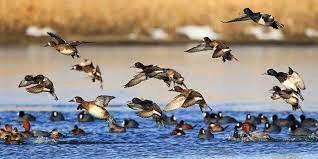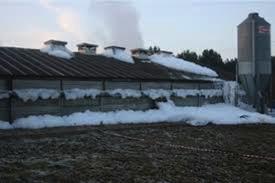 USDA-APHIS has reported isolation and outbreaks of H5N1 avian influenza with the responsible virus expressing H5 genes of Eurasian lineage. Outbreaks should be viewed against the extensive recovery of virus from migratory waterfowl in the Atlantic Flyway. From January 3rd through February 16th, surveillance has yielded H5N1 virus from 247 hunter-killed ducks of various species. States from which isolates have been recovered extending southward along the Atlantic Flyway include New Hampshire, Connecticut, Delaware, Virginia, North Carolina, South Carolina, Georgia, and Florida. As yet there have been no isolates reported from migratory birds along the Mississippi Flyway although it is recognized that surveillance was belatedly initiated in mid-February.
USDA-APHIS has reported isolation and outbreaks of H5N1 avian influenza with the responsible virus expressing H5 genes of Eurasian lineage. Outbreaks should be viewed against the extensive recovery of virus from migratory waterfowl in the Atlantic Flyway. From January 3rd through February 16th, surveillance has yielded H5N1 virus from 247 hunter-killed ducks of various species. States from which isolates have been recovered extending southward along the Atlantic Flyway include New Hampshire, Connecticut, Delaware, Virginia, North Carolina, South Carolina, Georgia, and Florida. As yet there have been no isolates reported from migratory birds along the Mississippi Flyway although it is recognized that surveillance was belatedly initiated in mid-February.
The backyard outbreaks comprised:-
- February 14th Fauquier County, VA.
- February 19th Suffolk County, NY.
- February 20th Knox County, ME.
- February 24th Kalamazoo County, MI.
The outbreaks in commercial flocks comprised:-
- February 9th Dubois County, IN. Turkeys, (‘Dubois 1’)
- February 9th Greene County, IN
- February 14th Fulton County, KY. Broilers (‘Fulton 1 and 2’)
- February 14th Webster County, KY Turkeys.
- February 15th Dubois County, IN. Turkeys (’Dubois 2)
- February 18th Greene County, KY. Turkeys (‘Greene 2’)
- February 22nd. Dubois County, IN. Turkeys (presumptive ‘Dubois 3’)
- February 23rd. Newcastle County, DE. Egg-production complex
A total of 120,000 growing turkeys were depleted in Indiana and 250,000 broilers and 55,000 turkeys in Kentucky.
 Doubtless there will be more isolates from migratory waterfowl with the extent and frequency a function of intensity of surveillance. Backyard flocks that are allowed outside access will be at risk of infection although these clusters of birds in suburban aras are of minimal significance in the epidemiology of avian influenza. Outbreaks in commercial flocks are to be expected with sporadic cases diagnosed both as an index flock with contact flocks usually in the same complex with a common feed source and service personnel. The optimistic projections by Tom Vilsack, Secretary of the USDA on future outbreaks of HPAI in 2022 are somewhat premature. The industry will do its best with effective and in some cases “make-belief” biosecurity but there is a lot of virus being shed by migratory waterfowl.
Doubtless there will be more isolates from migratory waterfowl with the extent and frequency a function of intensity of surveillance. Backyard flocks that are allowed outside access will be at risk of infection although these clusters of birds in suburban aras are of minimal significance in the epidemiology of avian influenza. Outbreaks in commercial flocks are to be expected with sporadic cases diagnosed both as an index flock with contact flocks usually in the same complex with a common feed source and service personnel. The optimistic projections by Tom Vilsack, Secretary of the USDA on future outbreaks of HPAI in 2022 are somewhat premature. The industry will do its best with effective and in some cases “make-belief” biosecurity but there is a lot of virus being shed by migratory waterfowl.
The level of biosecurity in commercial poultry production complexes is infinitely higher than in 2015 when the U.S. experienced an epornitic along the Mississippi Flyway The response of state and federal authorities is rapid and effective in diagnosing and depleting affected flocks. To date, nine floor-housed flocks that have been infected were depleted using foam. There has been no official comment on the method of depopulation in the Delaware layer flock or the status of the flock in New Jersey under common ownership.